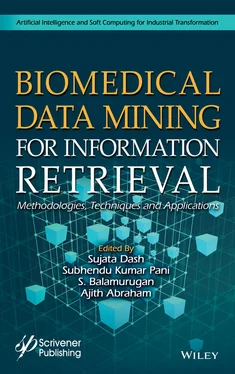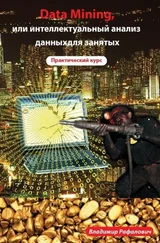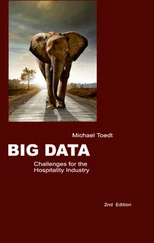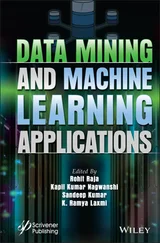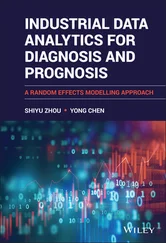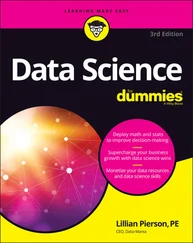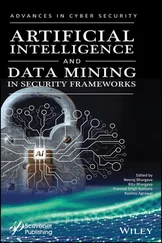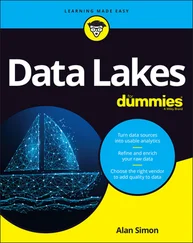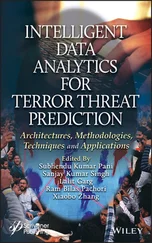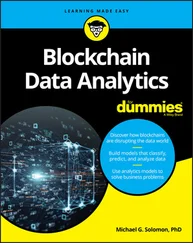1 Cover
2 Title Page
3 Copyright
4 PrefaceIntroduction Organization of the Book Concluding Remarks
5 1 Mortality Prediction of ICU Patients Using Machine Learning Techniques 1.1 Introduction 1.2 Review of Literature 1.3 Materials and Methods 1.4 Result and Discussion 1.5 Conclusion 1.6 Future Work References
6 2 Artificial Intelligence in Bioinformatics 2.1 Introduction 2.2 Recent Trends in the Field of AI in Bioinformatics 2.3 Data Management and Information Extraction 2.4 Gene Expression Analysis 2.5 Role of Computation in Protein Structure Prediction 2.6 Application in Protein Folding Prediction 2.7 Role of Artificial Intelligence in Computer-Aided Drug Design 2.8 Conclusions References
7 3 Predictive Analysis in Healthcare Using Feature Selection 3.1 Introduction 3.2 Literature Review 3.3 Dataset Description 3.4 Feature Selection 3.5 Feature Selection Methods 3.6 Methodology 3.7 Experimental Results and Analysis 3.8 Conclusion References
8 4 Healthcare 4.0: An Insight of Architecture, Security Requirements, Pillars and Applications 4.1 Introduction 4.2 Basic Architecture and Components of e-Health Architecture 4.3 Security Requirements in Healthcare 4.0 4.4 ICT Pillar’s Associated With HC4.0 4.5 Healthcare 4.0’s Applications-Scenarios 4.6 Conclusion References
9 5 Improved Social Media Data Mining for Analyzing Medical Trends 5.1 Introduction 5.2 Literature Survey 5.3 Basic Data Mining Clustering Technique 5.4 Research Methodology 5.5 Results and Discussion 5.6 Conclusion & Future Scope References
10 6 Bioinformatics: An Important Tool in Oncology 6.1 Introduction 6.2 Cancer—A Brief Introduction 6.3 Bioinformatics—A Brief Introduction 6.4 Bioinformatics—A Boon for Cancer Research 6.5 Applications of Bioinformatics Approaches in Cancer 6.6 Bioinformatics: A New Hope for Cancer Therapeutics 6.7 Conclusion References
11 7 Biomedical Big Data Analytics Using IoT in Health Informatics 7.1 Introduction 7.2 Biomedical Big Data 7.3 Healthcare Internet of Things (IoT) 7.4 Studies Related to Big Data Analytics in Healthcare IoT 7.5 Challenges for Medical IoT & Big Data in Healthcare 7.6 Conclusion References
12 8 Statistical Image Analysis of Drying Bovine Serum Albumin Droplets in Phosphate Buffered Saline 8.1 Introduction 8.2 Experimental Methods 8.3 Results 8.4 Discussions 8.5 Conclusions Acknowledgments References
13 9 Introduction to Deep Learning in Health Informatics 9.1 Introduction 9.2 Deep Learning in Health Informatics 9.3 Medical Informatics 9.4 Bioinformatics 9.5 Pervasive Sensing 9.6 Public Health 9.7 Deep Learning Limitations and Challenges in Health Informatics References
14 10 Data Mining Techniques and Algorithms in Psychiatric Health: A Systematic Review 10.1 Introduction 10.2 Techniques and Algorithms Applied 10.3 Analysis of Major Health Disorders Through Different Techniques 10.4 Conclusion References
15 11 Deep Learning Applications in Medical Image Analysis 11.1 Introduction 11.2 Deep Learning Models and its Classification 11.3 Convolutional Neural Networks (CNN)—A Popular Supervised Deep Model 11.4 Deep Learning Advancements—A Biological Overview 11.5 Conclusion and Discussion References
16 12 Role of Medical Image Analysis in Oncology 12.1 Introduction 12.2 Cancer 12.3 Medical Imaging 12.4 Diagnostic Approaches for Cancer 12.5 Conclusion References
17 13 A Comparative Analysis of Classifiers Using Particle Swarm Optimization-Based Feature Selection 13.1 Introduction 13.2 Feature Selection for Classification 13.3 Use of WEKA Tool 13.4 Conclusion and Future Work References
18 Index
19 End User License Agreement
1 Cover
2 Table of Contents
3 Title page
4 Copyright
5 Preface
6 Begin Reading
7 Index
8 End User License Agreement
1 Chapter 1 Figure 1.1 Step by step process for mortality prediction. Figure 1.2 The FLANN based mortality prediction model. Figure 1.3 Convergence characteristics of FA-FLANN based mortality prediction mo...
2 Chapter 2 Figure 2.1 The different level of organization of protein.
3 Chapter 3Figure 3.1 Diabetes dataset class distribution.Figure 3.2 Class distribution of hepatitis dataset.Figure 3.3 Flow chart of the tasks carried out in this chapter.
4 Chapter 4Figure 4.1 Basic architecture and components of e-health architecture.Figure 4.2 Healthcare 4.0 protection and security necessities.
5 Chapter 5Figure 5.1 Steps involved in Data mining process. http://www.lastnightstudy.com/...Figure 5.2 Components of data mining system. https://www.ques10.com/p/9209/expla...Figure 5.3 Major Social media sites. https://www.securitymagazine.com/articles/8...Figure 5.4 Social network representation using graph. https://www.javatpoint.com...Figure 5.5 An example of clustering. https://www.analyticsvidhya.com/blog/2013/1...Figure 5.6 Partition clustering [18].Figure 5.7 Hierarchical clustering [19].Figure 5.8 Obstacle in Constraint-Based Clustering [42].Figure 5.9 Decision tree [42].Figure 5.10 Categorization of social media data [43].Figure 5.11 Frame work for proposed system.Figure 5.12 Basic steps of page rank algorithm. https://www.analyticsvidhya.com/...Figure 5.13 Output generated after Pre processing step. Stop Word algorithm has ...Figure 5.14 (a) Pre processing; (b) Graph clustering.Figure 5.15 Apply k-mean algorithm.Figure 5.16 Generation of clustering data.Figure 5.17 Output of K-means algorithm.Figure 5.18 Apply back propagation algorithm.Figure 5.19 Result of clustering.Figure 5.20 Classified data.Figure 5.21 Performance comparison of proposed algorithm and other existing meth...Figure 5.22 Execution time.
6 Chapter 6Figure 6.1 Bioinformatics tools used in cancer research.Figure 6.2 Cancer genomic databases based on bioinformatics.Figure 6.3 Procedure of SELDI-MS-TOF based on bioinformatics.
7 Chapter 7Figure 7.1 Big Data: 6 V’s.Figure 7.2 Google research trend IoT Health and Big Data Health.Figure 7.3 Big Data Flow from its sources to storage, analytics, and visualizati...Figure 7.4 Healthcare IoT system architectureFigure 7.5 Healthcare IoT monitoring architecture [10].
8 Chapter 8Figure 8.1 BSA saline droplets at different initial PBS concentrations (Ø): The ...Figure 8.2 (I–IV) shows the time evolution of the first-order statistical (FOS) ...Figure 8.3 (I–IV) show the comparison of the averaged gray level co-occurrence m...Figure 8.4 (I–IV) show the time evolution of the gray level co-occurrence matrix...Figure 8.5 The images of the dried films of BSA-saline are captured after 24 h a...Figure 8.6 Histograms depicting the counts of the pixels along the y-axis, and t...
9 Chapter 9Figure 9.1 Neural network architecture.Figure 9.2 Basic architecture of DNN.Figure 9.3 Basic structure of CNN.Figure 9.4 Basic structure of DBN.Figure 9.5 Basic architecture of RNN.Figure 9.6 Basic architecture of DA.Figure 9.7 Summary of the proposed model.
10 Chapter 10Figure 10.1 Percentages of data mining techniques applied to Alzheimer’s studies...Figure 10.2 Percentages of data mining techniques applied to Dementia’s studies ...Figure 10.3 Percentages of data mining techniques applied to depression studies ...Figure 10.4 Percentages of data mining techniques applied to Schizophrenia and b...
11 Chapter 11Figure 11.1 Image depicting prostate cancer cell segmentation (Source—Alan Parti...Figure 11.2 Basic neural network design.Figure 11.3 Various neural network architectures. (a) Recurrent Neural network, ...Figure 11.4 An illustration of a typical CNN architecture for pixel RGB images (...Figure 11.5 (a) Input Image, (b) Convolutional filter and (c) Convolved output v...Figure 11.6 Average versus max pooling with a stride of 2.Figure 11.7 Basic CNN architecture for image classification [55].Figure 11.8 Image denoising of brain MR image by DnCNN network [26].
Читать дальше
